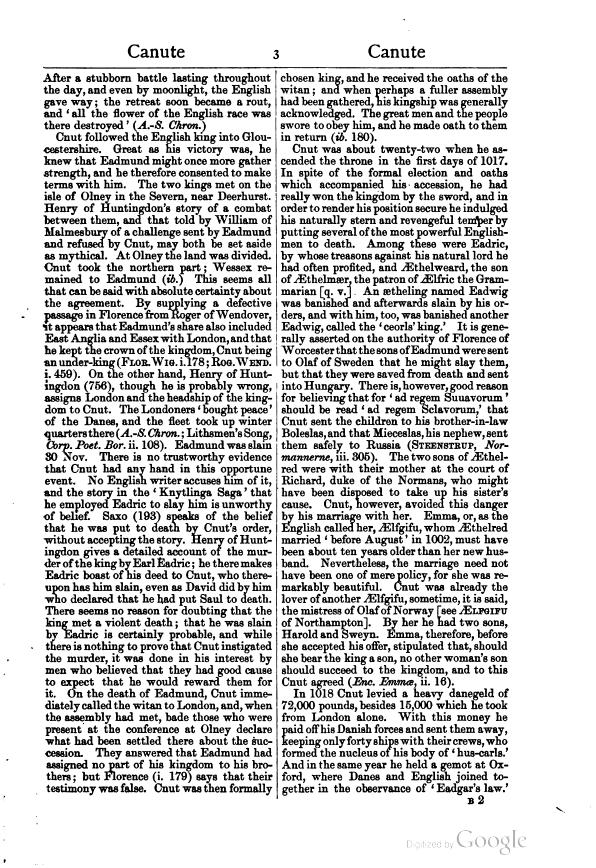After a stubborn battle lasting throughout the day. and even by moonlight, the English gave way; the retreat soon became a rout, and 'all the flower of the English race was there destroyed (A.-S. Chron.)
Cnut follow the English King into Gloucestershire. Great as his victory was, he knew that Eadmund might once more gather strength, and he therefore consented to make peace with him. The two kings met on the isle of Olney in the Severn, near Deerhurst. Henry of Huntingdon's story of a combat between them, and that told by William of Malmesbury of a challenge sent by Eadmund and refused by Cnut, may both be set aside as mythical. At Olney the land was divided. CbhI took the northern part; Wessex remained to Eadmond (ib.) This seems all that can be said with absolute certainty about the agreement. By supplying a defective passage in Florence from Roger of Wendover, it appears that Eadmund's share also included East Anglia and Essex with London, and that he kept the crown of the kingdom, Cnut being an under-king (Flor. Wig i. 178; Rog. Wend. i. 459). On the other hand, Henrv of Huntingdon (756), though he is probably wrong, assigns London and the headdhip of the kingdom to Cnut. The Londoners 'bought peace' of the Danes, and the fleet took up winter quarters there (A.-S. Chron.; Lithsmen's Song, Corp. Pott. Bor. ii 108), Eadmund was slain 30 Nov. There is no trustworthy evidence that Cnut had any hand in this opportune event. No English writer accuses him of it, and the story in the 'Knytlinga Saga' that he employed Eadric to slay him is unworthy of belief. Saxo (193) speaks of the belief that he was put to death by Cnut's order, without accepting the story. Henry of Huntingdon gives a detailed account of the murder of the king by Earl Eadric: he there makes Eadric boast of his deed to Cnut, who thereupon has him slain, even as David did by him who declared that he had put Saul to death. There seems no reason for doubting that the king met a violent death; that he was slain by Eadric is certainly probable, and while there is nothing to prove that Cnut instigated the murder, it was done in his interest by men who believed that they had good cause to expect that he would reward them for it. On the death of Eadmund, Cnut immediately called the witan to London, and, when the assembly had met, bade those who were present at the conference at Olney declare what had been settled there about the succession. They answered that Eadmund had assigned no part of his kingdom to his brothers, but Florence (i. 179) says that their testimony was false. Onut was then formally chosen king, and he received the oaths of the witan; and when perhaps a fuller assembly had been gathered, his kingship was generally acknowledged. The great men and the people swore to obey him, and he made oath to them in return (ib. 180).
Cnut was about twenty-two when he ascended the throne in the first days of 1017. In spite of the formal election end oaths which accompanied his accession, he had really won the kingdom by the sword, and in order to render his position secure be indulged his naturally stern and revengeful temper by putting several of the most powerful Englishmen to death. Among these were Eadric, by whose treasons against his natural lord he had often profited, and Æthelweard, the son of Æthelmær, the patron of Ælfric the Grammarian [q. v.] An ætheling named Eadwig was banished and afterwards slain by his orders, and with him, too, was banished another Eadwig, called the 'ceorls' king.' It is generally asserted on the authority of Florence of Worcester that the sons of Eadmund were sent to Olaf of Sweden that he might slay them, but that they were saved from death and sent into Hungary. There is, however, good reason for believing that for 'ad regem Suuavorum' should be read 'ad regem Sclavorum,' that Cnut sent the children to his brother-in-law Bolealas, and that Miecealas, his nephew, sent them safely to Russia (Steenstrup, Normannerne, iii. 305). The two sons of Æthelred were with their mother at the court of Richard, duke of the Normans, who might have been disposed to take up his sister's cause, (Cnut, however, avoided this danger by his marriage with her.) Emma, or, as the English called her, Ælfgifu, whom Æthelred married 'before August' in 1002, must have been about ten years older than her new husband. Nevertheless, the marriage need not have been one of mere policy, for she was remarkably beautiful. Cnut was already the lover of another Ælfgifu, sometime, it is said, the mistress of Olaf of Norway [see Ælfgifu of Northampton]. By her he had two sons, Harold and Sweyn. Emma, therefore, before she accepted his offer, stipulated that, should she bear the king a son, no other woman's son should succeed to the kingdom, and to this Cnut agreed (Enc. Emmæ, ii., 16).
In 1018 Cnut levied a heavv danegeld of 72,000 pounds, besides 15,000 which he took from London alone. With this money he paid off his Danish forces and sent them away, keeping only forty ships with their crews, who formed the nucleus of his body of 'hus-carls.' And in the same year he held a gamot at Oxford, where Danes and English joined together in the observance of 'Eadgar's law.'
